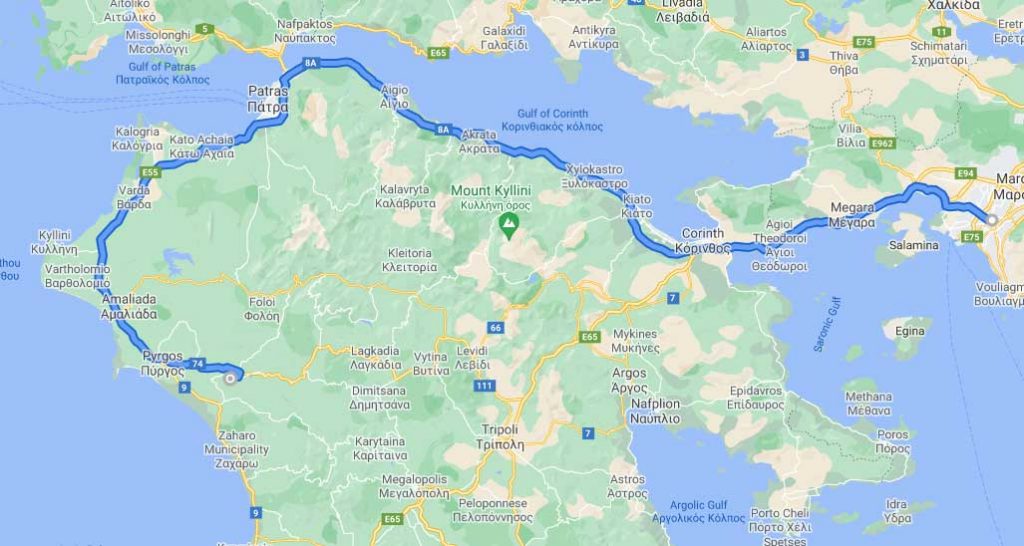Olympia the ancient city of Olympia in Greece
Olympia is the birthplace of the Olympic Games and Zeus‘ sacred place, Olympia has cultivated ideals since ancient times. It was never just the games, but also the honour, the peace, the struggle and the body – all in one. Visiting the archaeological site and museum, you will walk in one of the most important sanctuaries of ancient Greece. Situated in the landscape of Ilia, by the foot of Mt. Kronion (Kronios Lofos), Olympia invites you to take part of the history of Greece.
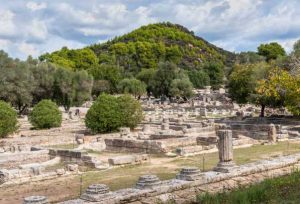 It is famous for being the site of the Olympic Games in antiquity, comparable in weight to the Pythian Games (one of the four Panhellenic Games in ancient Greece ) held in Delphi.
It is famous for being the site of the Olympic Games in antiquity, comparable in weight to the Pythian Games (one of the four Panhellenic Games in ancient Greece ) held in Delphi.
Both games were held every four years with almost no interruptions for almost 1,200 years. Only in the 4th century CE were they finally abolished by the Christian emperor of Rome Theodosius I.
Olympia is truly one of the largest and most attractive places in Greece, and the setting is as perfect as one would imagine: a lush valley of wild olive trees and plane trees, spreading next to the Twin Rivers of Alpheus-the largest in the Peloponnese – and Kladhios and overlooked by pine-covered hill of Kronos.
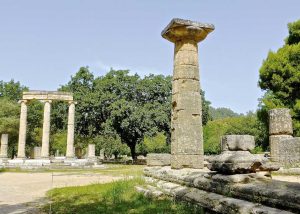 Sadly, the very ruins of the sanctuary are cluttered and confusing, and seem to call for reconstruction, even on a modest scale. The large temple columns lie half-buried among the trees and undergrowth: picturesque and shady, perfect base for picnics, but do not offer much real picture of their ancient grandeur or function.
Sadly, the very ruins of the sanctuary are cluttered and confusing, and seem to call for reconstruction, even on a modest scale. The large temple columns lie half-buried among the trees and undergrowth: picturesque and shady, perfect base for picnics, but do not offer much real picture of their ancient grandeur or function.
Their fame, however, takes precedence over circumstance, and walking through the vault from the sanctuary to the stadium, it is difficult not to feel reverence for the Olympic history. Despite the crowds, tour buses, souvenir shops and other traps of mass tourism, it requires and deserves a long visit.
Mythology
Olympia is connected to many gods and myths, and there are different versions on how the Olympic Games got started. According to one version, this was where Zeus struggled with his father Cronus, finally beating him and seizing the throne. As a memory of his victory, Zeus made the games.
Another myth tells us that it was the five brothers that brought up Zeus on Crete that started them. They raced in Olympia, and the oldest brother Heracles (not the hero) crowned the winner with an olive wreath.
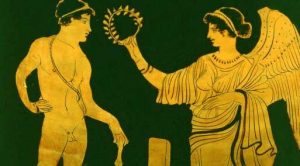 Yet another story tells us about king Oenomaus of Pisa, whose daughter Hippodameia had reached marrying age. This worried the king, since an oracle had told him that he would die by the hand of his son-in-law, and so he conceived of a wicked plan that would prevent Hippodameia from ever getting married. He made an announcement that any suitor would have to compete with him in a chariot race. If the suitor won, he would get Hippodameias’ hand, but if he lost, he would die.
Yet another story tells us about king Oenomaus of Pisa, whose daughter Hippodameia had reached marrying age. This worried the king, since an oracle had told him that he would die by the hand of his son-in-law, and so he conceived of a wicked plan that would prevent Hippodameia from ever getting married. He made an announcement that any suitor would have to compete with him in a chariot race. If the suitor won, he would get Hippodameias’ hand, but if he lost, he would die.
So, the races begun. Despite the risk of losing their life, many suitors challenged the king, not knowing that the evil king had Ares‘ invincible horses. After Oenomaus had beaten, and killed, 33 suitors, Pelops arrived. As soon as she saw him, Hippodameia fell desperately in love, and conspired with the king’s charioteer Myrtilos to help Pelops.
Myrtilos sabotaged the king’s chariot by pulling out the bolt that held one of the wheels in its place, and after the race had started the chariot fell apart in the first turn. The king was caught in his horses reins and dragged to death. Pelops and Hippodameia married, and the games were to be held in order to remember the day Pelops won over the sly king.
History
The area of Olympia was already inhabited in the beginning of the 2nd Millennium BC, if not earlier. There was a cult here before Zeus, probably to Gaea.
Tradition holds that the first Olympic Games were held in 776BC, but they might actually have started way before then. The games were a peace treaty between Sparta and Elis, and it was soon decided that all Greek states could take part in them as long as they respected the sacred truce that must be held during the games. This period of peace was for a month at first, but because so many states took part and people from all over came to watch, it was extended to three months, always during summer.
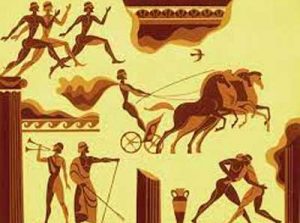 Because the sacred truce gave the kings and leaders from all over Greece a chance to meet unarmed, Olympia became an important place for political discussions and trade. It also enhanced the feeling of unity amongst the Greeks, along with the language and religion.
Because the sacred truce gave the kings and leaders from all over Greece a chance to meet unarmed, Olympia became an important place for political discussions and trade. It also enhanced the feeling of unity amongst the Greeks, along with the language and religion.
Olympia was to be renovated many times, and new buildings were added through the ages. Famous people came here to watch the games, such and Plato and Aristotle, and before them, in the 6th century BC, Thales of Miletus had died of a heat stroke here. Gelon and Hieron of Syracusae were to compete in the games, and so was Alcibiades, Alexander the Great and Nero.
Slaves and women, especially married ones, were strictly forbidden to watch the games, and if a woman was caught as a spectator, she was immediately thrown off Mt. Typaeon.Women could compete though, and besides that, the Heraia were also held here; foot races for young maids in the area.
Barbarians were allowed to watch, but not to compete. A competitor had to be a free, unpunished Greek and he had to have trained for the games in his home for ten months, and for one month in Olympia. The winners did not receive any money, but were greatly honored. The prize was an olive wreath from Zeus holy tree, and the winner was allowed to raise a victory statue. In his hometown he would usually be given free meals for the rest of his life, and it is said that a town with a champion would tear down its wall since they no longer needed one with such an athlete as a citizen.
From the year 472 the games were held during five days in stead of the original one. On the first day the competitors would register, take a sacred oath that they had trained for ten months and that they would respect the rules. On this day there was a competition between the heralds. On the second day the horse races and Pentathlon were held. On the third the track races took place. On the fourth there was wrestling, boxing and Pancrateon. On the fifth day the prizes were handed out, with celebrations following.
During the Classical period the great temple of Zeus was built. Olympia was his sanctuary and he had an oracle here. Inside the temple stood the statue of the god, made by Phidias. We only know about this statue through coins and descriptions, and it was supposedly 13,5 meters (37,5 feet) high. It pictured a sitting Zeus with the goddess Nike in his right hand and a sceptre in his left. The statue was made of gold and ivory, and was considered one of the seven wonders of the ancient world. It disappeared towards the end of the 4th century AD.
The greatness of Olympia was now bigger than ever, and the victory against the Persians had enhanced the feeling of unity amongst the Greeks even further. Many new buildings were added, and the baths from this period are the oldest in the world: complete with a swimming pool and a sauna.
In the 4th century BC the whole stadium was moved to the East and slopes were made on the sides for the spectators. Alexander the Great completed his fathers building Philippeion and competed himself during the games. He didn’t win, but proved to be a good loser.
The Romans conquered Greece in the 2nd century BC and they took many of the treasures of Olympia with them. Sulla even tried to relocate the games to Rome, but failed. Even so, the Olympic Games lost their importance and were just held for show. During Augustus reign Olympia’s status was enhanced again. Statues of the emperor and his family and descendants were to be put in the sanctuary.
Nero came to Greece in AD 67 and took part in the horse races. Although he fell off his chariot he had himself declared winner, and then took many statues with him.
Herodes Atticus was to build a nympheum here, and its fountain provided the area with drinking water.
Because Germanic tribes ravaged Athens and the Peloponnese, many buildings were torn down in the 3rd century, and the materials were used to build fortifications in Olympia. They never actually came here, but in the 4th century the games were banned by emperor Theodosius. The whole sanctuary was shut down in 426. One of the main reasons was the the Olympic Games were now considered pagan by the Christian emperor, and the competitors nakedness highly immoral.
In the 6th century earthquakes destroyed the buildings in Olympia, and it was filled with mud from the flooded rivers Kladeos and Alfeos. Landslides from Mt. Kronion finally covered the whole area up.
The sanctuary was discovered in 1776, and in 1829 French archaeologists started excavating the site. The first modern Olympic Games were held in Athens in 1896. The irony of it all is that the ancient games would stop the wars, but the modern ones have been stopped by wars on a few occasions.
Ancient Olympia map
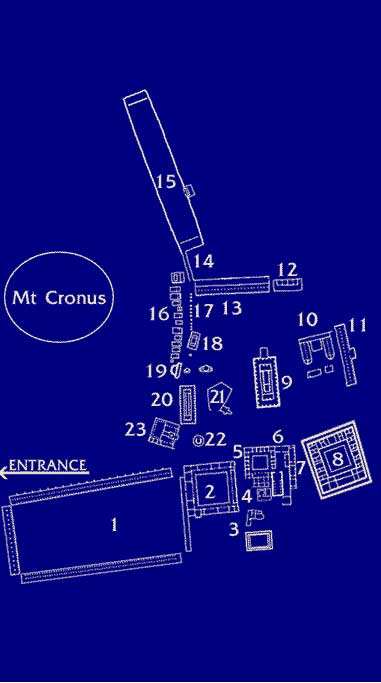
1. The Gymnasium – Here the athletes would exercise running and long-jumping.
2. The Palaestra – This is where they would train wrestling and pankration.
3. The Thermai – The baths
4. The Heroon – Monument to the unknown hero
5. The Theokoleon – Priests’ quarters
6. Phedias’ Workshop
7. Phaidryntai House – Here the care-takers of the statues lived.
8. The Leonidaion – A guesthouse for noble men.
9. The Temple of Zeus 10. The Bouleuterion – This is where the Olympic Committee sat.
11. The Southern Stoa – marketplace
12. Hestias’ Sanctuary
13. The Echo Hall – Here the announcements were made, echoing seven times.
14. The Krypte – The Entrance to the stadium
15. The Stadium
16. The Treasure Houses
17. The Statues of Zeus, or Zanes
18. The Metroon – Temple to the Great Mother
19. Herodes Atticus’ Nymphaeum
20. The Temple of Hera
21. The Pelopion – Monument to Pelops
22. The Philippeion – Monument to Philip II
23. The Prytaneion – Where feasts were held
Museum of Olympia
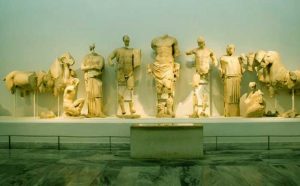 Just opposite the archaeological site is the museum. It has a big model plan of how the site must have looked in its day, and many interesting artifacts.
Just opposite the archaeological site is the museum. It has a big model plan of how the site must have looked in its day, and many interesting artifacts.
The best known artworks are the sculpture of Hermes by Praxiteles, Nike of Paionius, Miltiades‘ helmet and the pediments from the temple of Zeus, picturing the myth of Peleus and Hippodameia on one side, and the myth of Apollo, the Centaurs and the Lapiths on the other.
There are also several objects from the actual games – what the athletes would use competing or cleaning themselves, as well as votive offerings that people would dedicate to the gods in order to get cured
Getting to Olympia
Directions to Ancient Olympia by public transit
By Bus
From Athens you can take the KTEL bus from Kifisou Avenue to Pyrgos
From Patras the KTEL bus to Pyrgos
By the Suburban railway
Athens-Pyrgos- Ancient Olympia
By car
From Athens to Patra via the National Highway 5 E55 – continue to Pygos on Highway 9 – from Pyrgos to Ancient Olympia via the route 74
See Map below
